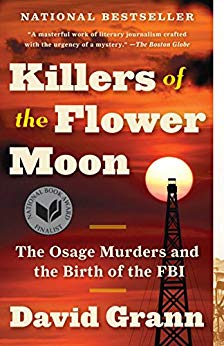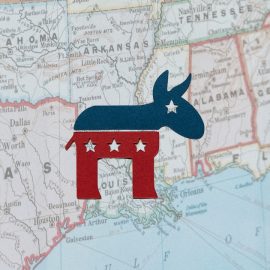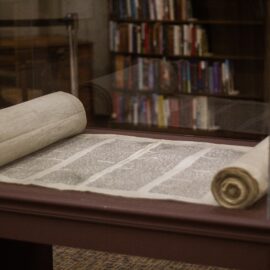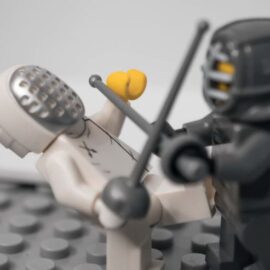

This article is an excerpt from the Shortform summary of "Killers of the Flower Moon" by David Grann. Shortform has the world's best summaries of books you should be reading.
Like this article? Sign up for a free trial here .
Who was Ernest Burkhart? Did he play a role in the Osage murder conspiracy in the 1920s?
Ernest Burkhart is a key figure in the Osage murders. Working alongside his uncle William Hale, Burkhart systematically murdered his wife’s Osage family members in order to steal the wealth she accumulated from oil.
Read about Ernest Burkhart and his trial.
Ernest Burkhart: The Background
First, let’s place Ernest Burkhart in context. On May 27, 1921, the partially decomposed body of a 25-year-old Osage woman named Anna Brown was discovered in a ravine in Osage County, Oklahoma, dead from a bullet to the back of the head. Anna would be merely one of the first victims in a five-year-long Reign of Terror that would run from 1921 to 1926 and claim the lives of dozens (and possibly hundreds) of Osage men, women, and children.
Anna’s immediate family included her sisters, Mollie Burkhart and Rita Smith, and her mother, Elizabeth Kyle. Mollie was married to a white man named Ernest Burkhardt, a native of Texas who had moved to Osage County as a young man. Rita and Anna had also married white men.
But Anna’s murder was to be just the beginning. About a week after her body was discovered, another Osage victim was found near an oil rig. This time, the corpse belonged to a man named Charles Whitehorn, who had been missing for about two weeks. Whitehorn was a well-known and popular figure in Osage County, married to a half-white, half-Cheyenne woman. Like Anna Brown, he had been shot in the head—and the bullets appeared to be the same kind as the ones that had killed Anna Brown.
Because she spoke English and was married to a white man, Mollie became the family’s natural liaison with the white authorities. But this was also due to the fact that she wasn’t married to just any white man. Her husband, Ernest Burkhart, was the nephew of William Hale, one of the most prominent figures in Osage County.
Mollie testified to the local justice of the peace that she had last seen Anna in the company of her brother-in-law, Bryan Burkhart. Bryan testified that he had dropped Anna off at home early in the evening, after which he’d gone back into town. The authorities even briefly detained both Bryan and Ernest Burkhart, though the evidence against them at this time was purely circumstantial and they were soon released.
The Headright Plot
The Osage Tribal Council had decreed that each member of the tribe was to receive an equal share of the royalties from the oil money, known as headrights. Individuals were not permitted to buy or sell headrights—this was done in an attempt to keep the oil money in Osage hands. But they could be inherited. An Osage who suffered many deaths in their family could find himself or herself the owner of multiple headrights.
As he studied the probate records, investigator Tom White discovered that many headrights had come into the possession of Mollie Burkhart, married to Ernest Burkhart, nephew of William Hale. Ernest was known to be highly influenced by his domineering uncle. When all of this money came to Mollie, it would be easy for Hale to exercise control of it through his nephew—though it would be even easier if Mollie were to be killed, too.
Ernest Burkhart: A Suspect
In October 1925, White received a new tip, this time from a prisoner in the Oklahoma state penitentiary named Burt Lawson. Lawson claimed that his wife had carried on an affair with Bill Smith, while he had been working as Smith’s ranch hand. His jealousy and bitterness toward Bill Smith had made him an easy target when the Hale conspiracy came to recruit him. Lawson claimed that, in early 1921, Ernest Burkhart and William Hale had offered him $5,000 to place the fuse under the Smith house that set off the explosion. Hale had even provided him with the tools for making the bomb, including the nitroglycerin and the coiled fuse. Lawson, after some pressure by Hale, agreed to set up the explosive device and detonate it. He had waited until he was sure Bill and Rita were asleep and then lit the fuse, watching the house blow up.
In January 1926, U.S. Marshals arrested Ernest Burkhart. Hale, meanwhile, confidently and politely strolled in to the county sheriff’s office to surrender.
Ernest Burkhart: The Trial
The trial was devastating for Mollie, as she learned more about the plot to eliminate her family. The national press, which avidly covered the case, refused to respect her privacy, circulating photos of her around the country and generally portraying her as an ignorant, backwoods Osage. Hale, meanwhile, packed the gallery with his supporters, who would hoot and cheer at every motion made by the defense and jeer and boo the prosecution. It brought a circus-like atmosphere to the trial and amply demonstrated the difficulties of bringing a white man to justice for crimes against an Osage Indian.
During the trial, Hale’s team lied and blatantly tampered with the witness Ernest Burkhart and attempted to intimidate him into silence. Shockingly, the judge allowed all of this to happen in open court. On one occasion, Hale openly berated Burkhart personally, in full view of the judge and jury. White was outraged and appalled by the utter brazenness and arrogance of Hale’s conduct.
Now, under the pressure of Hale’s backroom scheming, Ernest recanted his testimony, claiming that he knew nothing about the murders and taking the stand as a witness for the defense instead of the prosecution. Outrageously, he claimed that White’s agents had only obtained his confession through torture—a lie that was echoed by Hale and Ramsey. White’s one-time star witness was being used against him.
Although J. Edgar Hoover back in Washington knew these charges against the Bureau to be totally baseless, he was fearful of anything that might bring further embarrassment or scandal to the Bureau. Behind the scenes, there was mounting political pressure to sack White and his team.
To bolster their position against Hale, the prosecution decided to first seek a conviction of Ernest Burkhart. With Ernest recanting, however, their case looked like it was falling apart. But the prosecution had one more card to play: Kelsie Morrison, the notorious bootlegger, outlaw, onetime Bureau informant, and the man whom Ernest had fingered as Anna Brown’s killer. The prosecutor brought Morrison in to take the stand. This time, Morrison decided to cooperate with the government against his former employer, Hale. Morrison confessed in open court that he had been recruited by Hale to help eliminate Mollie’s entire family. He then proceeded to narrate the awful details of Anna’s final moments.
He and Bryan Burkhart had gotten Anna drunk at a speakeasy before driving her out to Three Mile Creek. Bryan’s wife, Cole (who corroborated all the details of Morrison’s testimony) waited in the parked car to stand lookout. They then dragged the inebriated Anna down into the ravine. Bryan propped her up on a rock and held her still while Morrison shot her in the back of the head—with a gun that had been provided by Hale.
Ernest Burkhart could now see the tide turning in the case. On June 9, 1926, he notified the prosecutors that he wished to change his plea again, this time to “guilty.” He read a statement before the judge and jury that he had, in fact, hired Kirby to blow up Rita and Bill Smith’s house and admitted that his story about torture at the hands of federal agents was a fabrication.
Accordingly, Ernest Burkhart was sentenced on June 21, 1926, to life imprisonment. For Mollie, it was a day of devastation. During the trial, she had been ostracized by everyone she knew, both white and Osage. Her now four-year-old daughter Anna, whom she had sent to live with a relative out of fear for her safety, had suddenly and unexpectedly died. Although there was no evidence of foul play in this latest awful tragedy in Mollie’s life, the Osage had come to regard every death as inherently suspicious. Now, Mollie learned that her beloved husband had conspired to murder her sisters and brother-in-law.
Ernest Burkhart was rightfully convicted of murder, though this did little to bring peace to his suffering wife, Mollie. Ernest Burkhart’s murder campaign left lasting effects on the community and the Osage people.

———End of Preview———
Like what you just read? Read the rest of the world's best summary of David Grann's "Killers of the Flower Moon" at Shortform .
Here's what you'll find in our full Killers of the Flower Moon summary :
- How the Osage tribe had vast oil wealth, but had it seized by their murderous neighbors
- The brutal and unresolved murders of Osage Native Americans
- The complicated history of the FBI in profiting from the Osage murders






